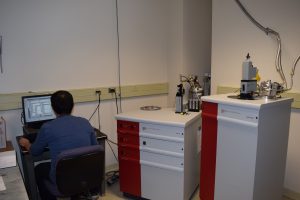Superconducting Quantum Interference Device (SQUID) magnetometer
 FIRST houses a state-of-the art superconducting quantum interference device (SQUID) magnetometer purchased from a generous grant from the NSF Major Research Instrumentation program (NSF-1040006). This instrument provides UMaine researchers the ability to perform high resolution magnetic and electrical measurements over the temperature ranges of 4 – 800 Kelvin (-456 to 980 oF) and magnetic field ranges of 0 – 7 Tesla (over 10 million times the magnetic field strength of the Earth). This versatile instrument provides solutions for a unique class of sensitive experiments in key areas of materials science and is especially suitable for analysis of thin films, powders, wafers, and single crystals. The modular design integrates a SQUID detection system, a precision temperature control unit residing in the bore of a high-field superconducting magnet, and a sophisticated computer operating system. These new capabilities are especially valuable to several research programs at UMaine pertaining to surface magnetism in nanoparticles, magnetic anisotropies in sedimentary rocks, electrical transport in physical and chemical sensing devices, and magnetic nanoparticle based biosensors. As an example, this instrument allows us to measure magnetic moments from samples that are one million times weaker than the signal from a piece of iron.
FIRST houses a state-of-the art superconducting quantum interference device (SQUID) magnetometer purchased from a generous grant from the NSF Major Research Instrumentation program (NSF-1040006). This instrument provides UMaine researchers the ability to perform high resolution magnetic and electrical measurements over the temperature ranges of 4 – 800 Kelvin (-456 to 980 oF) and magnetic field ranges of 0 – 7 Tesla (over 10 million times the magnetic field strength of the Earth). This versatile instrument provides solutions for a unique class of sensitive experiments in key areas of materials science and is especially suitable for analysis of thin films, powders, wafers, and single crystals. The modular design integrates a SQUID detection system, a precision temperature control unit residing in the bore of a high-field superconducting magnet, and a sophisticated computer operating system. These new capabilities are especially valuable to several research programs at UMaine pertaining to surface magnetism in nanoparticles, magnetic anisotropies in sedimentary rocks, electrical transport in physical and chemical sensing devices, and magnetic nanoparticle based biosensors. As an example, this instrument allows us to measure magnetic moments from samples that are one million times weaker than the signal from a piece of iron.
The instrument has served as a focal point for training undergraduates, graduate students, postdocs, and visiting scientists in magnetic materials, nanotechnology, biophysics, and materials science and is a critical tool for expanding the capacity of UMaine research into magnetic aspects of nanotechnology, biophysics, sensor technology, and materials science. The instrument is relatively easy to operate and provides direct information on electron spin interactions, and thus it is a powerful tool to teach physics and nanotechnology concepts to several different constituents participating in UMaine outreach activities, including K-12 students and teachers, the general public, under-represented groups, and industry partners. Information collected from the instrumentation is disseminated via many outlets, including publications and presentations, a dedicated website, and technology tours.
For more information, please contact Prof. Robert Meulenberg (robert.meulenberg@maine.edu)
